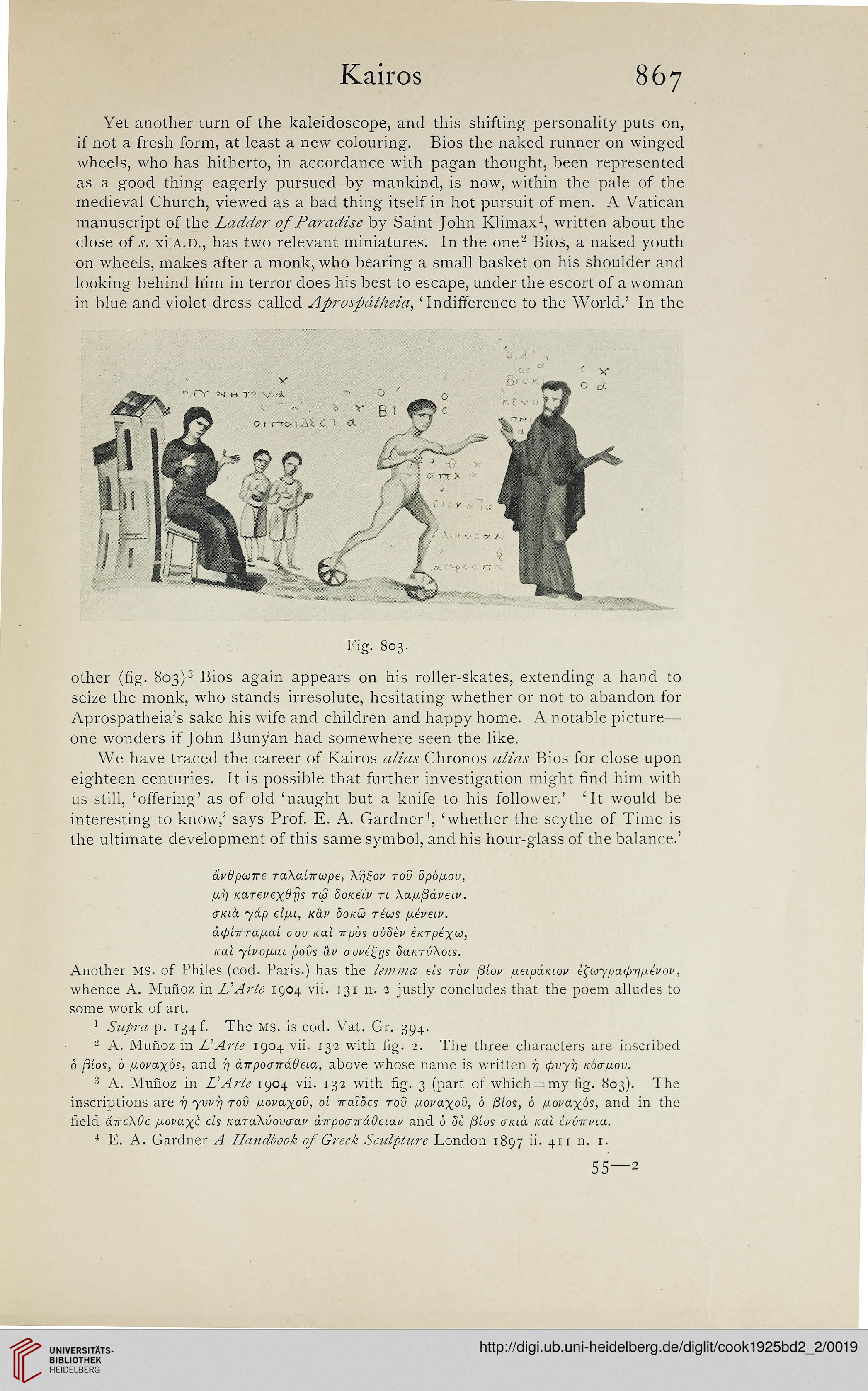Yet another turn of the kaleidoscope, and this shifting personality puts on,
if not a fresh form, at least a new colouring". Bios the naked runner on winged
wheels, who has hitherto, in accordance with pagan thought, been represented
as a good thing eagerly pursued by mankind, is now, within the pale of the
medieval Church, viewed as a bad thing itself in hot pursuit of men. A Vatican
manuscript of the Ladder of Paradise by Saint John Klimax1, written about the
close of s. xi a.d., has two relevant miniatures. In the one2 Bios, a naked youth
on wheels, makes after a monk, who bearing a small basket on his shoulder and
looking behind him in terror does his best to escape, under the escort of a woman
in blue and violet dress called Aprospdtkeia, 'Indifference to the World.' In the
•x"
Fig. 803.
other (fig. 803)3 Bios again appears on his roller-skates, extending a hand to
seize the monk, who stands irresolute, hesitating whether or not to abandon for
Aprospatheia's sake his wife and children and happy home. A notable picture—
one wonders if John Buny'an had somewhere seen the like.
We have traced the career of Kairos alias Chronos alias Bios for close upon
eighteen centuries. It is possible that further investigation might find him with
us still, 'offering' as of old 'naught but a knife to his follower.' 'It would be
interesting to know,' says Prof. E. A. Gardner1, 'whether the scythe of Time is
the ultimate development of this same symbol, and his hour-glass of the balance.'
avdpuire TaXaiwcope, Xfj^ov too 8po/xov,
/xrj Karevexdjjs rip doxeiv tl \ap.(3avtLv.
(jKia yap ei/u.l, k&v 8okQ reus /xevetv.
atpiTTTafiaL aov Kal npbs ovdiv eKrpixu>
koI yivo/xai povs av avve^rjs datcrvXois.
Another MS. of Philes (cod. Paris.) has the lemma eis rbv j3iov fxeipaKiov e'ewyparpr^pevov,
whence A. Mufioz in VArte 1904 vii. 131 n. 2 justly concludes that the poem alludes to
some work of art.
1 Supra p. 134 f. The MS. is cod. Vat. Gr. 394.
2 A. Mufioz in VArte 1904 vii. 132 with fig. 2. The three characters are inscribed
6 (3ios, 6 pLovaxos, and 17 aTrpoair&deia, above whose name is written 17 (pvyri Koapov.
3 A. Mufioz in ZJ'Arte 1904 vii. 132 with fig. 3 (part of which = my fig. 803). The
inscriptions are 17 yvvri rod p,ovaxov, oi jraiSes rod fiovaxov, 6 f3ios, 6 p.ov<xxbs, and in the
field drreXde fxovaxe eis KaraKvovaav aTrpotjiradeLav and 6 Si (3ios ltkicl Kai ivvivvia.
4 E. A. Gardner A Handbook of Greek Sculpture London 1897 ii. 411 n. 1.
55—2
if not a fresh form, at least a new colouring". Bios the naked runner on winged
wheels, who has hitherto, in accordance with pagan thought, been represented
as a good thing eagerly pursued by mankind, is now, within the pale of the
medieval Church, viewed as a bad thing itself in hot pursuit of men. A Vatican
manuscript of the Ladder of Paradise by Saint John Klimax1, written about the
close of s. xi a.d., has two relevant miniatures. In the one2 Bios, a naked youth
on wheels, makes after a monk, who bearing a small basket on his shoulder and
looking behind him in terror does his best to escape, under the escort of a woman
in blue and violet dress called Aprospdtkeia, 'Indifference to the World.' In the
•x"
Fig. 803.
other (fig. 803)3 Bios again appears on his roller-skates, extending a hand to
seize the monk, who stands irresolute, hesitating whether or not to abandon for
Aprospatheia's sake his wife and children and happy home. A notable picture—
one wonders if John Buny'an had somewhere seen the like.
We have traced the career of Kairos alias Chronos alias Bios for close upon
eighteen centuries. It is possible that further investigation might find him with
us still, 'offering' as of old 'naught but a knife to his follower.' 'It would be
interesting to know,' says Prof. E. A. Gardner1, 'whether the scythe of Time is
the ultimate development of this same symbol, and his hour-glass of the balance.'
avdpuire TaXaiwcope, Xfj^ov too 8po/xov,
/xrj Karevexdjjs rip doxeiv tl \ap.(3avtLv.
(jKia yap ei/u.l, k&v 8okQ reus /xevetv.
atpiTTTafiaL aov Kal npbs ovdiv eKrpixu>
koI yivo/xai povs av avve^rjs datcrvXois.
Another MS. of Philes (cod. Paris.) has the lemma eis rbv j3iov fxeipaKiov e'ewyparpr^pevov,
whence A. Mufioz in VArte 1904 vii. 131 n. 2 justly concludes that the poem alludes to
some work of art.
1 Supra p. 134 f. The MS. is cod. Vat. Gr. 394.
2 A. Mufioz in VArte 1904 vii. 132 with fig. 2. The three characters are inscribed
6 (3ios, 6 pLovaxos, and 17 aTrpoair&deia, above whose name is written 17 (pvyri Koapov.
3 A. Mufioz in ZJ'Arte 1904 vii. 132 with fig. 3 (part of which = my fig. 803). The
inscriptions are 17 yvvri rod p,ovaxov, oi jraiSes rod fiovaxov, 6 f3ios, 6 p.ov<xxbs, and in the
field drreXde fxovaxe eis KaraKvovaav aTrpotjiradeLav and 6 Si (3ios ltkicl Kai ivvivvia.
4 E. A. Gardner A Handbook of Greek Sculpture London 1897 ii. 411 n. 1.
55—2




